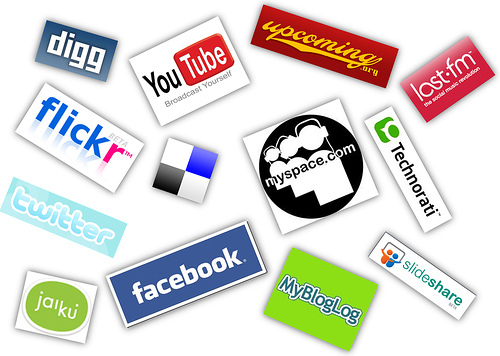From “The Social Network” (Press photo from Sony/Columbia Tristar)
Social networks have come to mean, in the computer sense, websites or platforms that people use to communicate with each other. They differ from e-mail or newsletters or RSS feeds in that everyone in the network can communicate with everyone else. Wikipedia defines Social Networking Services as:
A social networking service is an online service, platform, or site that focuses on building and reflecting of social networks or social relations among people, who, for example, share interests and/or activities. A social network service consists of a representation of each user (often a profile), his/her social links, and a variety of additional services. Most social network services are web-based and provide means for users to interact over the Internet, such as e-mail and instant messaging. Online community services are sometimes considered as a social network service, though in a broader sense, social network service usually means an individual-centered service whereas online community services are group-centered. Social networking sites allow users to share ideas, activities, events, and interests within their individual networks.
In the last few years such sites have become extremely important. Politicians no longer just have their own websites, they have Facebook pages, Twitter feeds, and YouTube channels. So do celebrities. Companies have turned to social media instead of traditional Customer Service channels. (Example: I wanted to know when the BBC would be making the new series of “Sherlock” available in its Global iPlayer. An e-mail to their online Feedback has gone unanswered for several weeks. A question on their Facebook was answered within a couple of days. (The answer was unsatisfactory — “We don’t know” — but at least it was an answer.)
When a site like Facebook has more than 800 million users, and expects to raise 5 billion dollars in its upcoming IPO (based on a 100 billion dollar evaluation), you know it is important.
The Different Faces of Social Media
Twitter, the microblogging service that allows anyone to post up to 140 characters, has become a news service, often replacing RSS. If there’s an event going on, from a rock concert to an Apple product announcement, Twitter is the fastest way to follow it as participants post developments. Twitter users subscribe to the posts of other users to follow friends, celebrities, media organizations, political parties, etc. But beyond that, through the use of hashtags (using the # character) they can search and follow trending subjects.
When one thinks of social networks, Facebook is probably the first that comes to mind, especially after the success of the film “The Social Network” which described its controversial founding. Facebook actually followed MySpace, which has declined, possibly because it was too centered on music, was just too ugly, or because Rupert Murdoch and his minions don’t really understand the Internet. (Example: for years the website for his key British satellite service B-Sky-B tried to be a news portal and it was virtually impossible to use if you wanted to find out about the service’s channels or had a problem with your subscription,)
In essence, Facebook is trying to recreate the old Walled Gardens of CompuServe and AOL, where users stayed within the service to communicate with others, find information, and play games. And now Google, having failed several times previously with social media platforms, is fighting back with its Google Plus.
But there are dozens and dozens of other social networking sites, and many “regular” websites are adding social components.
Perhaps the most successful of these is Amazon, with its user reviews. These are extremely useful in determining whether you will like a product. Feedback from other readers is a lot more informative than blurbs from publishers. Even if there is a risk a company will try to manipulate feedback, as recently happened, there is a such a mass of response that on the whole the reviews are apparently very trustworthy.
There are many more kinds of social media sites. News stories are shared on Reddit, Digg, and Boing Boing. Flickr and Instagram share photos, YouTube and sites like Justin.tv and Bambuser are places to post video. In music there is Spotify, Last.fm and other alternatives. Location services like Foursquare and Oink share reviews of places like restaurants. Getglue seeks to be a platform where people can post about movies, TV shows, books, and many other topics.
Many of the newer services (like Instagram and Oink) are only available as mobile apps, and the older websites are developing apps so users can post on the go. And of course, the clever move from Facebook and Twitter is encourage all the other services, and as many websites as possible, to allow visitors to like or post or retweet material. So no matter where you go on the Web, Twitter and Facebook become the center hub.
There are less obvious social spaces online. Wikis, where users can all edit material, are very collaborative, but there’s perhaps less personal interaction between users. People have updated Wikipedia articles I’ve created, improving them, but I’ve had no contact with them. On the opposite end of the spectrum are chat rooms, where people can interact, but the content is available only fleetingly. I listen and watch a number of podcasts from the Twit network, and they all rely heavily on an active chat room, catching errors, asking questions, and supplying facts instantly. But the experience can be very disconcerting, at least to someone who is not used to chat. The conversation seems to fly by at a mile a minute.
More my pace are good old-fashioned forums, which date back to BBS systems and Walled Gardens like CompuServe. Not only do comments remain around for later reference, forums give users a chance to build up online relationships.
Then there’s Second Life, an online world that looks like a game, but without the game. Participants can create whatever they like, can interact with others. A few years ago, when Sweden opened its “embassy” in Second Life, the site seemed like the future. Since then the service has declined, perhaps because the interface is so clumsy, just moving around is a trial, but perhaps also because there is no game play, so people don’t really know what to do there.
Facebook, of course, uses games like Farmville as part the strategy to keep people on the site. And no one can deny that such games are social, as players are force to interact with each other in producing their “crops” and gaining other advantages.
Online Games as Social Media
Massive multiplayer online games represent an overlooked type of social network, places where people hang out and interact, both in the game and in the accompanying support forums and unofficial websites.
But game designers have been slow to understand what they have created. For example, Sony Online Entertainment thought Star Wars Galaxies was “just a game”, their game, that they could change as they wished. When World of Warcraft came out, a jealous SOE revamped SWG with the “New Game Enhancements” to make it like WoW. The result was that SWG players who felt betrayed left the game, because someone had changed the rules of their community without asking them. And because people who liked the gameplay of WoW stayed there and did not move to SWG, the hoped for increase in numbers never happened. A few years later, in December 2011, SWG finally closed down, a lesson in how not to mess around with an online community.
One of the critics who reviewed the NGE, Allen Varney in “The Escapist”, pointed out that while Sony Online Entertainment thought they were just tweaking a game that was theirs to change, to the players SWG had become a community, and SOE messed with the basic structure of that community:
“…To increase subscribers, fix the game. It makes perfect sense – assuming subscribers think they’re playing a game.”
“…On November 3, 2005, SOE stunned players by announcing surprising “New Game Enhancements” that would go live on November 15. Why delay the announcement until two weeks before launch? “There were several other announcements related to the Star Wars franchise going on at the time,” Torres told GameSpy, “so we wanted to make sure that something this big didn’t get lost in the shuffle.”
“As WoW barreled toward 5 million subscribers, SOE launched SWG’s Publish 25. The NGE replaced the combat system with a shooter-style twitch game, reduced the value of crafting and entertaining, and collapsed 34 professions into nine classes. Jedi Knight powers, once obtained only after torturous grinding, were now widely available. Creature Handlers and Bio-Engineers, previously stunted by the CU, vanished.”
“…The launch, like the original game’s, went horribly: awful bugs, broken quests, lag. But these paled beside the main problem. For an unexpectedly huge number of players, the issue – the overriding issue that has burned in their heart down to, lo, this day and hour – was betrayal.
A minority of players liked, and still like, the NGE. But the Betrayed were legion, and they were loud. The official forums filled rapidly with complaints; admins pulled them and perma-banned many posters, who created independent “refugee” forums like Imperial Crackdown.”
“…To dismiss these players as mawkish, to tell them to get a life, misses the NGE’s lessons. These paying subscribers thought they had a life, and a community. Among a certain demographic, the distinction between meatspace and online – between “life” and “game” – grows increasingly arbitrary, like cash vs. credit cards. Having invested time building that part of their life, these players watched SOE, with brief warning and dubious justification, sweep it away.
For many younger players, it was their first encounter with betrayal. And as there is no love like your first love.”
SWG closed just as a new online game based on the Star Wars universe, Star Wars The Old Republic, launched. (Apparently Lucas Arts, the ultimate owners of both games, didn’t think their fans could handle two different online games.) I had a website in connection with my participation in SWG, Excalibur Starship. I’ve now converted it into a blog, looking back at the old game, but also comparing it to and following the development of SWTOR. There and here I plan to report on these online games as social media.
How much do the players interact with each other, or ignore each other? Are they forced to play together? How do in-game guilds and online forums support those interactions? Then there are more intimate virtual relationships. SWG included in-game weddings and SWTOR offers an opportunity to romance the NPC (computer generated) “companions” that are included in the gameplay, as well as other alternatives for flirting with NPC’s of the opposite gender (same sex intimate relationships seem off-limits in these games). Do these interactions affect real life relationships?
The relaunched blog is at:
sw-tor.se (as well as excaliburstarship.com).


